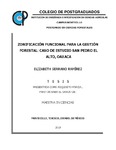| dc.contributor.author | Serrano Ramírez, Elizabeth | |
| dc.creator | SERRANO RAMÍREZ, ELIZABETH; 812822 | |
| dc.date.accessioned | 2019-05-22T13:23:14Z | |
| dc.date.available | 2019-05-22T13:23:14Z | |
| dc.date.issued | 2019-04 | |
| dc.identifier.uri | http://hdl.handle.net/10521/3190 | |
| dc.description | Tesis (Maestría en Ciencias Forestales).- Colegio de Postgraduados, 2019. | es_MX |
| dc.description.abstract | La planificación del manejo forestal requiere programar a detalle actividades en espacio y tiempo que permitan alcanzar objetivos económicos, ambientales y sociales. Para el propósito se utilizan diversas herramientas que permiten compatibilizar el cumplimiento de uno o más objetivos productivos, mientras se considera el potencial del bosque, las funciones ecosistémicas y la capacidad operativa de los gestores forestales. En el presente trabajo se propone un modelo de optimización basado en el enfoque de zonificación TRIAD, el cual sugiere dividir el área forestal bajo manejo en tres zonas: a) conservación, b) aprovechamiento maderable extensivo y c) aprovechamiento maderable intensivo, para maximizar el ingreso en términos de valor presente (VP), derivado del aprovechamiento forestal, y al mismo tiempo satisfacer restricciones operativas y de conservación de la biodiversidad. El modelo se implementó para el bosque bajo manejo de la comunidad de San Pedro El Alto, Oaxaca, México y fue resuelto mediante nueve técnicas heurísticas: búsqueda local simple (BLS), búsqueda local múltiple (BLM), multiarranque (MTA), tres técnicas hibridas conformadas por la técnica de recocido simulado en combinación con cada una de las anteriores mencionadas (RBLS, RBLM y RMTA), un algoritmo genético, en su versión simple (GNS), y dos variantes del mismo (GN2 y GN3 respectivamente). Los resultados obtenidos por cada técnica heurística fueron comparados entre sí y con plan de manejo actual definido por la comunidad de San Pedro El Alto. La técnica de recocido simulado con búsqueda local simple (RBLS) presentó el mejor rendimiento para obtener soluciones factibles que maximizan el ingreso total en el horizonte de planeación a la par que se respetan los criterios de zonificación. En general, los resultados señalan que las técnicas heurísticas de búsqueda guiada responden eficientemente al problema definido. _______________ FUNCTIONAL ZONING FOR FOREST MANAGEMENT: STUDY CASE OF SAN PEDRO EL ALTO, OAXACA. ABSTRACT: Forest management planning requires to program specific activities in space and time that allow meeting economic, environmental and social objectives. For this purpose, multiple tools are used to accomplish one or more productive objectives, considering the forest potential, ecosystem functions and the operative capacity or the landowners. In this work I propone a multiobjective optimization model based on the TRIAD zoning approach, which suggests dividing the forest under management into three zones types: a) biodiversity conservation, b) extensive timber production and c) intensive timber production, to maximize the present value (VP) of gains, derived from timber harvesting, while considering operative and conservation restrictions. The model was implemented for the managed forest owned by San Pedro El Alto community located in Oaxaca, Mexico. It was solved through nine heuristic techniques: local simple search (BLS), local beam search (BLM), multi-start (MTA), three hybrid techniques conformed by the simulated annealing technique in combination with each of the heuristics mentioned above (RBLS, RBLM, and RMTA), a genetic algorithm, in a simple version (GNS), and two variants of it (GN2 and GN3 respectively). The obtained results by each technique were compared among themselves and with the current forest management plan being carried out by the community of San Pedro El Alto. Simulated annealing with local simple search (RBLS), a hybrid technique, generated the best results, maximizing economic gains in the planning horizon while respecting the zoning criteria. In general, the results showed that techniques that use guided search respond efficiently to the defined problem. | es_MX |
| dc.description.sponsorship | Consejo Nacional de Ciencia y Tecnología (CONACyT). | es_MX |
| dc.format | pdf | es_MX |
| dc.language.iso | spa | es_MX |
| dc.rights.uri | http://creativecommons.org/licenses/by-nc-nd/4.0 | es_MX |
| dc.subject | Conservación de biodiversidad | es_MX |
| dc.subject | Manejo forestal | es_MX |
| dc.subject | Técnicas heurísticas | es_MX |
| dc.subject | Optimización | es_MX |
| dc.subject | Zonificación funcional | es_MX |
| dc.subject | TRIAD | es_MX |
| dc.subject | Biodiversity conservation | es_MX |
| dc.subject | Forest management planning | es_MX |
| dc.subject | Heuristic techniques | es_MX |
| dc.subject | Optimization | es_MX |
| dc.subject | Functional zoning | es_MX |
| dc.subject | Ciencias Forestales | es_MX |
| dc.subject | Maestría | es_MX |
| dc.subject.classification | CIENCIAS AGROPECUARIAS Y BIOTECNOLOGÍA::CIENCIAS AGRARIAS::CIENCIA FORESTAL | es_MX |
| dc.title | Zonificación funcional para la gestión forestal: Caso de estudio San Pedro El Alto, Oaxaca. | es_MX |
| dc.type | Tesis | es_MX |
| Tesis.contributor.advisor | Valdez Lazalde, José René | |
| Tesis.contributor.advisor | Santos Posadas, Héctor Manuel de los | |
| Tesis.contributor.advisor | Mora Gutiérrez, Román Anselmo | |
| Tesis.contributor.advisor | Ángeles Pérez, Gregorio | |
| Tesis.date.submitted | 2019 | |
| Tesis.date.accesioned | 2019 | |
| Tesis.date.available | 2019 | |
| Tesis.format.mimetype | pdf | es_MX |
| Tesis.format.extent | 17,808 KB | es_MX |
| Tesis.subject.nal | Conservación de la naturaleza | es_MX |
| Tesis.subject.nal | Natural resources conservation | es_MX |
| Tesis.subject.nal | Silvicultura sustentable | es_MX |
| Tesis.subject.nal | Sustainable forestry | es_MX |
| Tesis.subject.nal | San Pedro El Alto, municipio de Zimatlán de Álvarez, Oaxaca, México | es_MX |
| Tesis.rights | Acceso abierto | es_MX |
| Articulos.subject.classification | Bosques-México | es_MX |
| dc.type.conacyt | masterThesis | es_MX |
| dc.identificator | 6||31||3106 | es_MX |
| dc.contributor.director | VALDEZ LAZALDE, JOSÉ RENÉ; 26273 | |
| dc.audience | generalPublic | es_MX |


